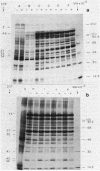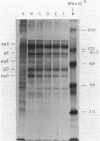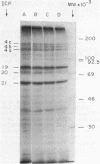Abstract
The antiherpesvirus agent (E)-5-(2-bromovinyl)-2'-deoxyuridine caused marked alterations in the synthesis and processing of several herpes simplex virus type 1 (HSV-1)-infected-cell polypeptides. Analogous to other thymidine analogs, there was a dose-dependent decrease in several beta and gamma polypeptides and an accumulation of HSV-1 thymidine kinase. In contrast to the action of other thymidine analogs, there were alterations in alpha polypeptides, including an increase in the synthesis and phosphorylation of infected-cell polypeptide 4b and a decrease in the synthesis of infected-cell polypeptide 27. The phosphorylation of several other HSV-1 phosphoproteins was mildly inhibited. (E)-5-(2-Bromovinyl)-2'-deoxyuridine inhibited the glycosylation of the major HSV-1 glycoproteins, and this activity appeared to be independent of the incorporation of the drug into the viral DNA. Thus, the alterations in HSV-1 polypeptide expression appear to be due to the presence of the drug in a low-molecular-weight form as well as its presence in the viral DNA. This suggests that this analog or a phosphorylated derivative might act as an inhibitor of an enzyme(s) responsible for posttranslational modification of polypeptides.
Full text
PDF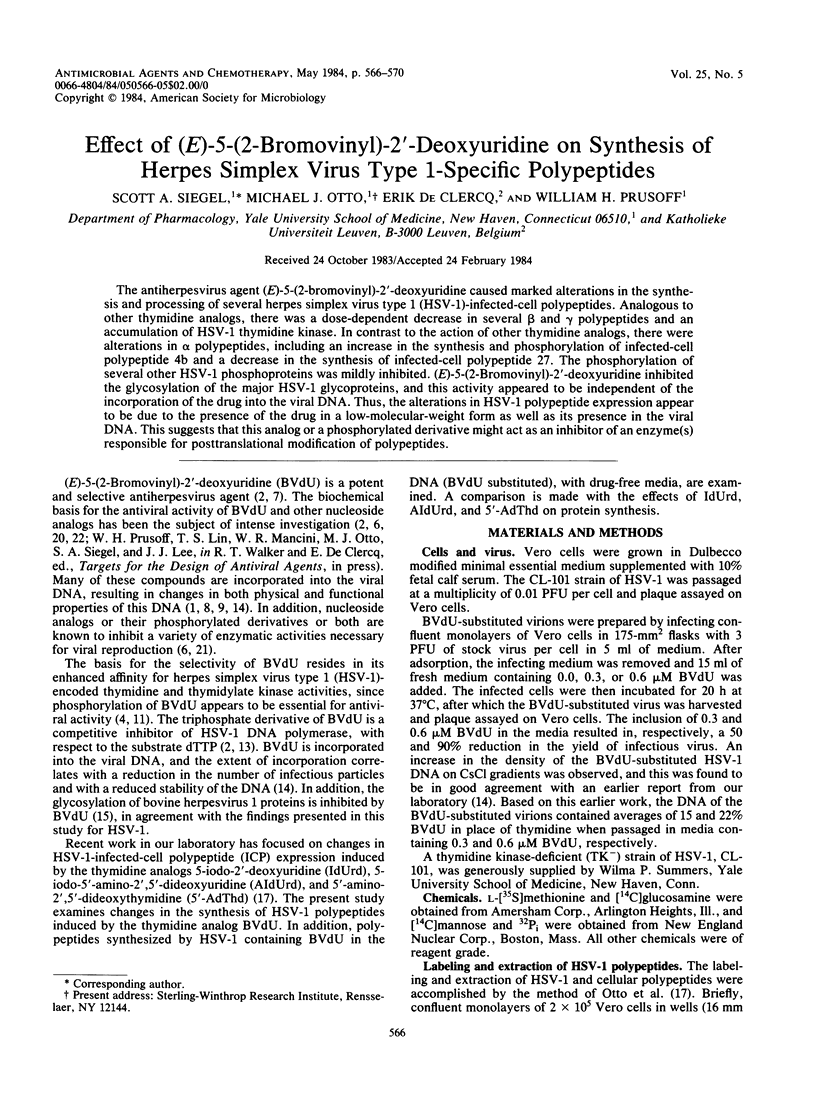
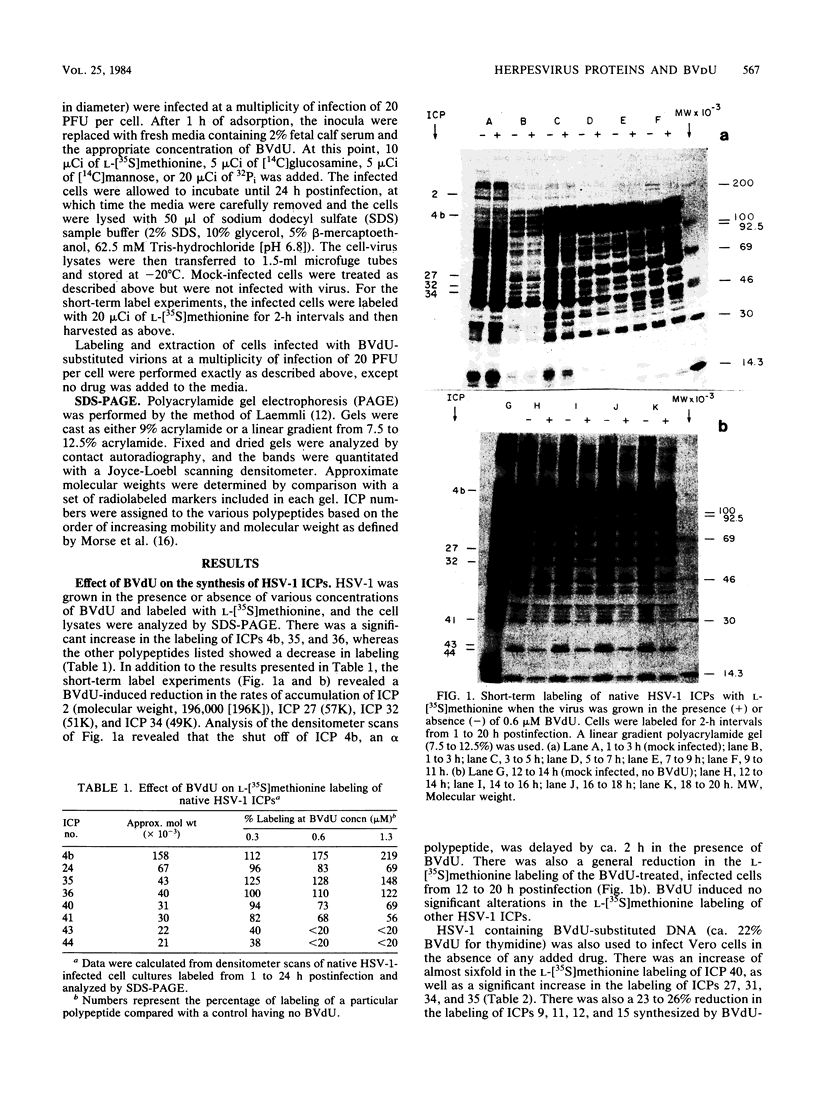

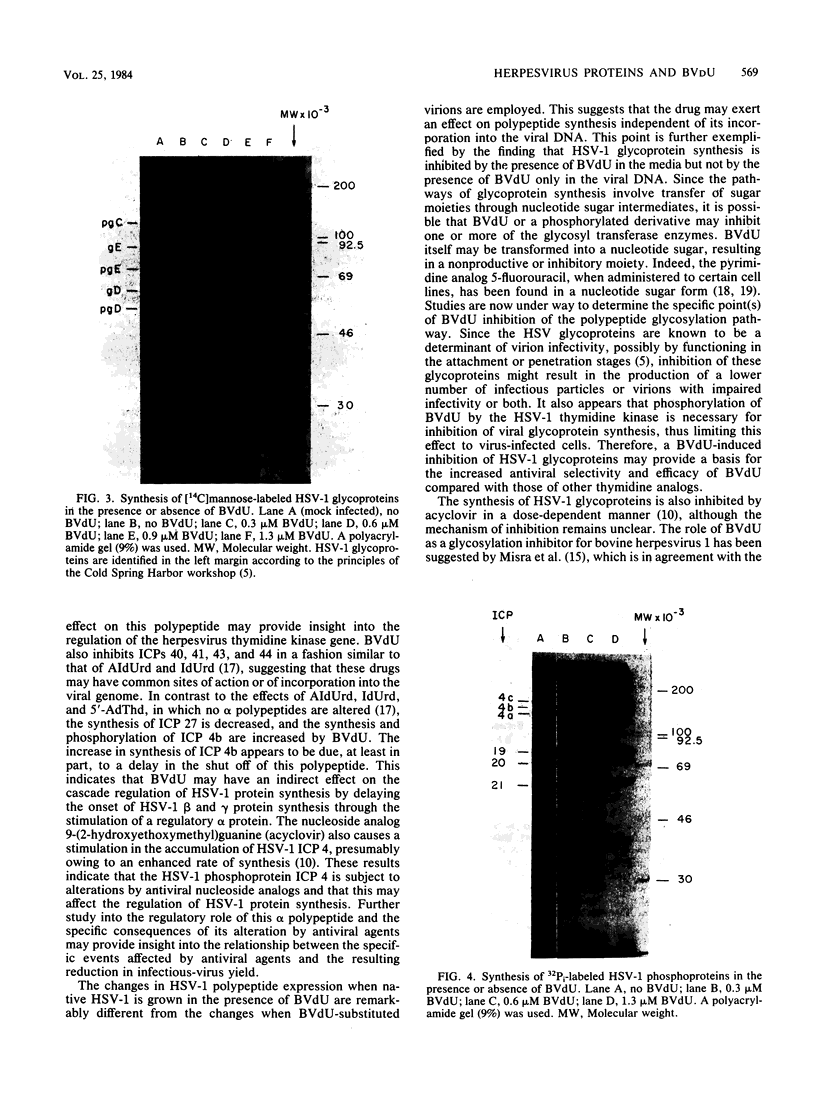

Images in this article
Selected References
These references are in PubMed. This may not be the complete list of references from this article.
- Allaudeen H. S., Chen M. S., Lee J. J., De Clercq E., Prusoff W. H. Incorporation of E-5-(2-halovinyl)-2'-deoxyuridines into deoxyribonucleic acids of herpes simplex virus type 1-infected cells. J Biol Chem. 1982 Jan 25;257(2):603–606. [PubMed] [Google Scholar]
- Allaudeen H. S., Kozarich J. W., Bertino J. R., De Clercq E. On the mechanism of selective inhibition of herpesvirus replication by (E)-5-(2-bromovinyl)-2'-deoxyuridine. Proc Natl Acad Sci U S A. 1981 May;78(5):2698–2702. doi: 10.1073/pnas.78.5.2698. [DOI] [PMC free article] [PubMed] [Google Scholar]
- Campadelli-Fiume G., Poletti L., Dall'Olio F., Serafini-Cessi F. Infectivity and glycoprotein processing of herpes simplex virus type 1 grown in a ricin-resistant cell line deficient in N-acetylglucosaminyl transferase I. J Virol. 1982 Sep;43(3):1061–1071. doi: 10.1128/jvi.43.3.1061-1071.1982. [DOI] [PMC free article] [PubMed] [Google Scholar]
- Cheng Y. C., Dutschman G., De Clercq E., Jones A. S., Rahim S. G., Verhelst G., Walker R. T. Differential affinities of 5-(2-halogenovinyl)-2'-deoxyuridines for deoxythymidine kinases of various origins. Mol Pharmacol. 1981 Jul;20(1):230–233. [PubMed] [Google Scholar]
- De Clercq E., Descamps J., De Somer P., Barr P. J., Jones A. S., Walker R. T. (E)-5-(2-Bromovinyl)-2'-deoxyuridine: a potent and selective anti-herpes agent. Proc Natl Acad Sci U S A. 1979 Jun;76(6):2947–2951. doi: 10.1073/pnas.76.6.2947. [DOI] [PMC free article] [PubMed] [Google Scholar]
- De Clercq E. Specific targets for antiviral drugs. Biochem J. 1982 Jul 1;205(1):1–13. doi: 10.1042/bj2050001. [DOI] [PMC free article] [PubMed] [Google Scholar]
- Fischer P. H., Chen M. S., Prusoff W. H. The incorporation of 5-iodo-5'-amino-2',5-dideoxyuridine and 5-iodo-2'-deoxyuridine into herpes simplex virus DNA. Relationship between antiviral activity and effects on DNA structure. Biochim Biophys Acta. 1980 Feb 29;606(2):236–245. doi: 10.1016/0005-2787(80)90033-7. [DOI] [PubMed] [Google Scholar]
- Fox L., Dobersen M. J., Greer S. Incorporation of 5-substituted analogs of deoxycytidine into DNA of herpes simplex virus-infected or - transformed cells without deamination to the thymidine analog. Antimicrob Agents Chemother. 1983 Mar;23(3):465–476. doi: 10.1128/aac.23.3.465. [DOI] [PMC free article] [PubMed] [Google Scholar]
- Furman P. A., McGuirt P. V. Effect of acyclovir on viral protein synthesis in cells infected with herpes simplex virus type 1. Antimicrob Agents Chemother. 1983 Feb;23(2):332–334. doi: 10.1128/aac.23.2.332. [DOI] [PMC free article] [PubMed] [Google Scholar]
- Fyfe J. A. Differential phosphorylation of (E)-5-(2-bromovinyl)-2'-deoxyuridine monophosphate by thymidylate kinases from herpes simplex viruses types 1 and 2 and varicella zoster virus. Mol Pharmacol. 1982 Mar;21(2):432–437. [PubMed] [Google Scholar]
- Laemmli U. K. Cleavage of structural proteins during the assembly of the head of bacteriophage T4. Nature. 1970 Aug 15;227(5259):680–685. doi: 10.1038/227680a0. [DOI] [PubMed] [Google Scholar]
- Larsson A., Oberg B. Selective inhibition of herpesvirus deoxyribonucleic acid synthesis by acycloguanosine, 2'-fluoro-5-iodo-aracytosine, and (E)-5-(2-bromovinyl)-2'-deoxyuridine. Antimicrob Agents Chemother. 1981 May;19(5):927–929. doi: 10.1128/aac.19.5.927. [DOI] [PMC free article] [PubMed] [Google Scholar]
- Mancini W. R., De Clercq E., Prusoff W. H. The relationship between incorporation of E-5-(2-Bromovinyl)-2'-deoxyuridine into herpes simplex virus type 1 DNA with virus infectivity and DNA integrity. J Biol Chem. 1983 Jan 25;258(2):792–795. [PubMed] [Google Scholar]
- Misra V., Nelson R. C., Babiuk L. A. Inhibition of glycosylation of bovine herpesvirus 1 glycoproteins by the thymidine analog (E)-5-(2 Bromovinyl)-2'-deoxyuridine. Antimicrob Agents Chemother. 1983 Jun;23(6):857–865. doi: 10.1128/aac.23.6.857. [DOI] [PMC free article] [PubMed] [Google Scholar]
- Morse L. S., Pereira L., Roizman B., Schaffer P. A. Anatomy of herpes simplex virus (HSV) DNA. X. Mapping of viral genes by analysis of polypeptides and functions specified by HSV-1 X HSV-2 recombinants. J Virol. 1978 May;26(2):389–410. doi: 10.1128/jvi.26.2.389-410.1978. [DOI] [PMC free article] [PubMed] [Google Scholar]
- Otto M. J., Lee J. J., Prusoff W. H. Effects of nucleoside analogues on the expression of herpes simplex type 1-induced proteins. Antiviral Res. 1982 Oct;2(5):267–281. doi: 10.1016/0166-3542(82)90050-x. [DOI] [PubMed] [Google Scholar]
- Peterson M. S., Ingraham H. A., Goulian M. 2'-deoxyribosyl analogues of UDP-N-acetylglucosamine in cells treated with methotrexate or 5-fluorodeoxyuridine. J Biol Chem. 1983 Sep 25;258(18):10831–10834. [PubMed] [Google Scholar]
- Pogolotti A. L., Jr, Nolan P. A., Santi D. V. Methods for the complete analysis of 5-fluorouracil metabolites in cell extracts. Anal Biochem. 1981 Oct;117(1):178–186. doi: 10.1016/0003-2697(81)90708-9. [DOI] [PubMed] [Google Scholar]
- Shugar D. Viral encoded enzymes of nucleic acid metabolism and their role in the development of antiviral agents. Prog Clin Biol Res. 1982;102(Pt 100):127–138. [PubMed] [Google Scholar]
- Sim I. S., Goodchild J., Meredith D. M., Porter R. A., Raper R. H., Viney J., Wadsworth H. J. Possible molecular basis for antiviral activity of certain 5-substituted deoxyuridines. Antimicrob Agents Chemother. 1983 Mar;23(3):416–421. doi: 10.1128/aac.23.3.416. [DOI] [PMC free article] [PubMed] [Google Scholar]



